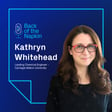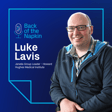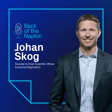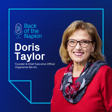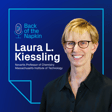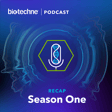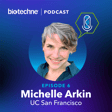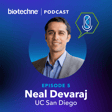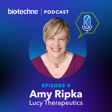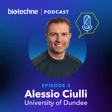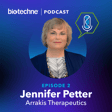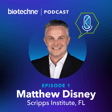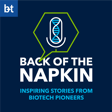Introduction to Scientific Pioneers
00:00:03
Speaker
A discovery is said to be an accident meeting a prepared mind. But every story behind a discovery is different. Perhaps the idea is conceived in a light bulb moment or a brainstorming session or captured in scribblings on the back of a napkin. Here we introduce you to scientific pioneers taking you beyond their publications and into innovation corner to hear the untold stories behind their discoveries.
00:00:33
Speaker
This podcast is brought to you by Biotechny, and I'm your host, Alex Maloney.
Breaking Limits in Cancer Research: KRAS Oncogene
00:00:43
Speaker
Undrugable. A term you'll have heard a few times on this podcast, but it's a word we now like to put quotation marks around as we've redefined the meaning of this. CARAS, the most common oncogene with the highest mutation rate in cancers. Undrugable.
00:01:00
Speaker
That was, until I guess today, Kevan Shokat saw this not as a fact but a challenge and well and truly broke through that glass ceiling. Kevan is a professor and chair in the Department of Cellular and Molecular Pharmacology at the University of California San Francisco and has a phenomenal background as both an academic and as an entrepreneur.
00:01:23
Speaker
Kevon's work has largely been in signal transduction pathways. That is the process by which a signal is transmitted through a cell as a series of molecular events, i.e. phosphorylation by protein kinases and GTPases like KRAS.
00:01:42
Speaker
understanding how these proteins work and function, particularly in cancer cells has been fundamental in advancing towards targeted cancer therapeutics. We talk about the cure for cancer as an all-encompassing statement, but this is what Kevan says he's striving for and considering KRAS mutations are present in around 30% of all tumors, it seems like we're on the right trajectory.
Ping Pong Skills and Postdoc Positions
00:02:10
Speaker
This is an awesome conversation with one of the biggest names in cancer research. So welcome to back of the napkin. Okay, Kevin, welcome to back of the napkin podcast. It's great to have you on. Thank you, Alex.
00:02:29
Speaker
So, Kevin, I wanted to squash a rumor before we started, and that's that you're so good at ping pong, you offer postdoc positions to anyone who can beat you, safe in the knowledge that no one's ever going to do that. Is this true? No, I just like postdocs that play really good ping pong.
00:02:52
Speaker
Very good. Yeah, I think I was scrolling down Twitter actually. I could see there was a video of you playing one of your grad students. Yeah, the quality looked pretty impressive, I have to say. Yeah, we had a fun Gordon conference a number of years ago, where after all the in the evening, we would have a nice healthy competition. That was fun. Very good. Very good.
00:03:17
Speaker
Okay, Kevon, let's take it back a little bit and get to know you a little better.
Early Chemistry Influence and Education
00:03:22
Speaker
Where did you grow up?
00:03:24
Speaker
I grew up here in California in the East Bay, in a town called Albany, which is next to Berkeley. And yeah, grew up there. My parents had a printing business, and so worked at their shop for many years through, you know, before high school, high school, college, and things like that. Nice. What were they printing?
00:03:51
Speaker
It was a commercial print shop. They did all kinds of things from books to business cards. They also published some books and things like that. Okay, so you are fully involved in getting ink all over the hands, I guess.
00:04:06
Speaker
Yeah, yes. Looking back on it, it was my first exposure to chemistry. The offset printing is full of the hydrophobic and the hydrophilic effects and transferring ink to paper.
00:04:26
Speaker
So that's where it all started. Yeah. And then so this piqued your interest and you wanted to go off and pursue a career in science. So talk me through this. Where did you where did you start? I went to a college called Reed College up in Portland, Oregon. And there I was, I think, thinking biology, you know, medicine. But I started taking the chemistry classes and it really
00:04:55
Speaker
you know, just the elegance and the logic of the periodic table and bonding and, you know, sort of things like that captured me. And so that just kept growing all through college. And then near the end, I was still thinking about medical school or PhD. And just my research was getting so fun and that so I ended up
00:05:21
Speaker
picking graduate school. When I met Peter Schultz, who became my advisor, that really put the finishing touch on that decision.
00:05:34
Speaker
Wow, so you're now doing a PhD in the lab of Peter Schultz at UC Berkeley, is that right? Yes, yes, yeah. And what were you looking at? What was your project? My project was on catalytic antibodies. So that was the time when the lab had sort of three different projects, catalytic antibodies, unnatural amino acid, neonogenesis, and
00:06:02
Speaker
sequence-specific DNA and RNA recognition and cleavage. So there were sort of three large efforts. And just the way the flow of projects went, the catalytic antibodies is the one I joined. So yeah, it was really fun because it was just trying to take everything we knew about enzymology and seeing if we could design new enzymes. And it was just
00:06:29
Speaker
absolutely loved the project and the people and working with Pete.
00:06:35
Speaker
Yeah, that sounds really exciting. What were group meetings like then? Because obviously, you know, those three things you mentioned, these are huge discoveries that kind of were sort of first, you know, the first kind of glimpse into what can be done when you start to mix some of these disciplines in chemistry and biology. So yeah, how were these kind of ideas being crafted and what did, I guess, what did you learn from your time there?
00:07:02
Speaker
Yeah, I think they were just so far out there, ideas that you could insert the 21st amino acid or that you could make an enzyme that nobody ever had made before.
00:07:19
Speaker
What really captivated me was the goal was just so, you know, you know, out of this world. But when you broke it down the way Pete did to individual steps necessary to achieve the goal,
00:07:37
Speaker
each step seemed plausible. I mean, it was plausible. You know, we need to do make this assay, we need to make this tRNA, we need to make this transition state analog. You know, everything was very doable. So I think the thing I took home, you know, I really amazed me was how you could take something that almost didn't
00:07:59
Speaker
you know, seemed like a fantasy and bring it down to concrete steps. And so the group meetings were really about, you know, this step, why, you know, what's going wrong? Why can't we, you know, get an antibody that will cleave an amide? Or why can't we put an amino acid on the tRNA? You know, it was so it was very
00:08:23
Speaker
technical like practical, you know, how do we get more of this molecule so that the next reaction can work? And so it was really, really fun to be, you know, in the weeds, but then knowing that you would climb up this mountain. Yeah. Yeah. Sounds really exciting. A really exciting time to be to be doing science. So what happened next, Kevin? What was the next chapter?
00:08:50
Speaker
Yeah, I kind of was, I mean, Pete was already a person that was doing so much chemical biology that there didn't seem to be that many other chemistry labs to go to that would teach me more biology. So I decided to go to, you know, a biochemistry or immunology lab and
00:09:16
Speaker
I think this kind of was an important point for me that I skipped over in choosing Pete's lab. But each time I'd made a decision in my career, it was really influenced by talking to somebody who gave me advice about who to talk to next. And so for Pete Schultz, it was one of my professors at Reed, a person named Nick Gallicatos that
00:09:42
Speaker
knew Pete and introduced me to him. So that was that introduction. And then in Pete's lab, my postdoc in the lab.
00:09:51
Speaker
had really suggested, he was an immunology graduate student that had come to Pete's lab and his name was Phil Patton and he knew Chris Goodenow and I then would become my postdoc advisor. And it's just people somehow when they tell you about somebody that knows you sort of
00:10:18
Speaker
really connects you to somebody who thinks you will connect with them and that's just so much more powerful than trying to hunt down people and things.
00:10:30
Speaker
Yeah, so that was really great. And so working with Chris and immunology at Stanford was really kind of my first major exposure to biological research, thinking about biology as a biologist. And yeah, it was good, but it was difficult to swing from the chemical sciences where you're engineering things to biology where you're studying things.
00:11:00
Speaker
I still struggle with that. I don't do a very good job when we have a paper that is like highly biological. It's just not my instinct. Yeah. Yeah. It seems to be the inverse of what most people would do is they would usually go from kind of, yeah, do it the other way around. Maybe it makes things a little easier. But yeah, it sounds like a really productive pathway
00:11:29
Speaker
through, Kevin. So what happened next then? So you do your postdoc at Stanford with Chris Good now. And then you go off to start your own group. Is that right? Yeah.
Launching a Lab at Princeton
00:11:43
Speaker
Yeah. I was kind of, because of my wife's job finishing in her residency, kind of shortened my postdoc a bit and began to look for jobs.
00:11:58
Speaker
mostly in chemistry departments, although I applied all over, but the only interviews I got were in chemistry departments. But I think I was too biological for the chemistry departments and too chemical for the biology departments. So it was a very kind of
00:12:15
Speaker
it got down to basically one university, Princeton, that had been looking for somebody to be a bridge between a molecular biology department and a chemistry department. That was the offer I received. That turned out to be just fantastic. It was a great environment to start a lab. I had
00:12:37
Speaker
really great colleagues like Dan Kahn, Suzanne Walker, Marty Semelhack, Arne Levine and you know started with great you know other professors that same time like Bonnie Bassler and things so it was a very very fun time.
00:12:54
Speaker
Yeah, great. And now you had your own group and the freedom to choose what you were going to work on. I guess you could think more about using chemical biology or using chemistry to answer biological questions. What were these questions that you wanted to answer?
00:13:14
Speaker
Yeah, that kind of was motivated from the postdoc in immunology. My lab mate, my cook, had been trying to understand which tyrosine kinases were defective in a self-tolerant or a self-intolerant state.
00:13:32
Speaker
And so that was kind of what he was, I think at the time, this is when people were identifying new tyrosine kinases, which ones are involved in T-cells, you know, fibroblasts. It was just a very, it was the heyday of the early kinase work.
00:13:48
Speaker
I realized, well, we don't know which kinase does which function. When I was still at Stanford, I really thought, okay, how can I figure out which kinase does which job in this lymphocyte or in any cell? I remember spending about nine months,
00:14:12
Speaker
coming up with ideas, having coffee with friends, bouncing them off them and never really hitting upon anything.
00:14:21
Speaker
The question was good, but I hadn't broken it down like I had said Pete did into doable steps. It was very Rube Goldberg and every, it was just not good. And I remember being at home with my son one time when he was just learning how to stand up. And so you have to kind of be attentive, but not that attentive. They're doing, they're okay on their own. And I remember just,
00:14:49
Speaker
occurring to me that, well, kinases all use ATP. So, why not exploit that and, you know, change the ATP, change the kinase. So, you know, switch, use genetics and protein engineering and chemistry together. And it just all of a sudden, you know, snapped into place. And so then that was
00:15:12
Speaker
the proposal that I went to Princeton with and started the lab with, and then it evolved from there and things, yeah.
00:15:21
Speaker
Is this the bump and hole work that you're referring to here? Yeah. Yeah, exactly.
Innovations in Kinase Research
00:15:27
Speaker
Yeah. Yeah. This looked really interesting. So what was it this bump and hole? How did this bump and hole approach work? Because there were a few instances of this happening around this time. Stuart Schreiber was doing something as well and yourself. So tell me more about this approach and how this then answered the question of, you know, what substrates are for which kind neighbors?
00:15:51
Speaker
Yeah, it kind of goes after the central challenge a lot in pharmacology or in any chemical biology, which is that we want to know how a small molecule interacts with a protein when it exerts its biological effect.
00:16:11
Speaker
That is incredibly hard to prove something. If you use the genetics, which is highly specific to engineer one kinase, then you can make its pocket bigger than the rest of the kinases. Then you make an ATP analog that only fits into that mutant.
00:16:36
Speaker
When you create the wild type situation or the situation where there's a hole in the kinase of interest, and if you add your molecule to the one with the engineered system, you can look at its effects, but you have this beautiful control where you add the molecule to the wild type.
00:16:56
Speaker
and you see what happens. So, the only difference is the mutation and the only difference is the chemical derivative on them. So, it's really just, you know, so powerful and I think that's why a lot of people hit upon it around the same time. You know, Stuart engineered FKBP's. People, Bruce Conklin had engineered GPCR's.
00:17:22
Speaker
I worked with Peter Gillespie to engineer myosins later. One of the first instances actually was ironically a GTPase where there was a group that engineered the EFTU GTPase
00:17:39
Speaker
to accept XTP, xanthine triphosphate, but not GTP. So they were able to count how many cycles of GTPase were required for every amino acid insertion. So that I only uncovered when I got to Princeton, but finding that paper really was like, oh, this is a good idea because look at how much they did in that system. So that was really
00:18:08
Speaker
You know, it was kind of, that was kind of, I think one of the first pump and hole things and it's still very useful for people. Yeah. Yeah. Really nice. Really nice work, Kevin. So, uh, you then moved to UCSF or is this kind of while that works ongoing or is this when that kind of work wraps up? Yeah, that was kind of, yeah, that, that was kind of the kind of,
00:18:34
Speaker
the beginning of that whole mutant kinase work. We were about five years into that. And a kind of thing, very interesting thing happened in 1999 as I was at Princeton, but thinking about moving, which is that Gleevec, the BCR-ABL inhibitor was approved.
00:18:55
Speaker
and it was kind of 96, 97, 98, 99, you could start to hear the stories of patients with this. So it kind of realized, wow, that we were working on kinases for the pure curiosity of what does what, but in parallel,
00:19:16
Speaker
these kinases are oncogenic and people are making drugs for them. So, starting in 1999 and when I moved here, just the whole area of drug discovery in kinases was increasing. So, that also was a shift for us. Did this change how you were thinking about kinases then? Did you become more translationally focused then in your work?
00:19:42
Speaker
Yeah, it wasn't, I wouldn't say that we did things to make drugs, but what we really, it was this other crazy coincidence was, I believe the paper was in about 2001 from Charles Sawyer's, who was working with patients with BCR-ABL and the Gleevec drug, and he published a paper that,
00:20:08
Speaker
was analyzing patients that became resistant to Gleevec and why they became resistant. And he identified a single point mutation that occurred in multiple patients. And the residue that was mutated was our residue, what we called the gatekeeper from the bump and hole approach. And we were just like, and you know,
00:20:35
Speaker
excited our paper that showed that this residue controlled specificity without all. So we had engineered something and then lo and behold it was going on in the patients. So that kind of was another big, really interesting kind of moment.
00:20:53
Speaker
So that kind of those two things, GLIVAC approved, resistance coming in this mutation that we had been spending, you know, three, four years before identifying, you know, just like what is going on here? We didn't mean to be studying this and it's right in front of us.
00:21:11
Speaker
Yeah, that must have been a really nice coincidence for you to then, yeah, stumble across. This is, yeah, this is fantastic. And you said kind of ironically, and referring to the GTPases because the GTPases and Ras has obviously been a huge thrust of the work that you do
Inspiration and Focus on KRAS
00:21:30
Speaker
now. So can you introduce us to this work as well? When did you start thinking about the GTPases?
00:21:37
Speaker
Yeah, I knew about the GTPases and I knew about KRAS.
00:21:46
Speaker
But I didn't really appreciate, you know, how important it was, you know, that it was the first human oncogene, that it was the most common oncogene. Until I came to UCSF and in my recruiting visits, I met Frank McCormick, who was the head of the Cancer Center and who had been the, you know, onyx company that had started to target Ras. And so he,
00:22:14
Speaker
He'd worked in all of the oncogenes and the pathways. We shared this kinase interest, but he was really focused on Ras. He kept pushing me to think about how to attack Ras.
00:22:33
Speaker
I just remember those first years, you know, 2000 to 2004, 2006. He he kept inviting, you know, the big, you know, luminaries in the Ras field like a bidding offer. Roger Goody, Julian Downward, you know, Channing Durr, other people to give talks and would make sure I was there. And, you know, just I got to absorb, you know, the the
00:23:02
Speaker
people's experience with RAS. And that just kind of kept me thinking about it. But to be honest, for almost 10 years, it just seemed so impossible. We didn't touch it. We didn't even start anything. The early efforts are on the phytosol transferase inhibitors, right? Was this something that you started on? I didn't really start on that so much. That was just kind of
00:23:31
Speaker
that was going on when I was at Princeton and kind of wrapping up. So I was kind of aware of it. I didn't even understand why it had not worked. Frank explained that to me and sort of I read more. And we did work on pharnasal transphrase afterwards, but it didn't pan out for us.
00:23:51
Speaker
Yeah, it was kind of like this background kind of stuff I would keep track of, but it wasn't any projects. Yeah. Yeah. So you thought there was possibly going to be another approach to target RAS, which was to go directly after the so-called undrugable protein itself. So tell me how you started to think about this then, Kevin, because for someone to say you can't
00:24:19
Speaker
There's no pockets on this that you can find. You've got the GTP and GDP pockets, but these are kind of peak emolio. You'll have to get a million times better at drug discovery if you want to go after that site. So how did you approach this?
00:24:35
Speaker
Yeah, you know, this was again kind of the benefit of being at UCSF. I think there were a lot of labs working on cysteine kinds of chemistry. My graduate school lab mate, bench mate, Andrew Bryce did, was actually a co-founder of Cinesis with Jim Wells. And so,
00:25:02
Speaker
When I moved back here, I visited them and they explained their tethering thing, which I thought was really elegant. I got exposed to this incredibly highly efficient drug discovery on cysteines and then my colleague Jack Tonton next to me
00:25:22
Speaker
Sort of have very closely aligned and shared labs and he was working on some beautiful Sistine chemistry as well so I was always kind of seeing students seeing talks, you know and and then you know just got kind of
00:25:40
Speaker
always kept looking back at Ras and noticing that, well, there are some cysteines, but nobody talks about them. That's always the aspartate. So once I got that approach in line of sight, we started to play with some nucleotide chemistry, but that got really hard for us. And afterwards, that's the approach that actually Nathaniel Gray's lab
00:26:09
Speaker
published on, but we were having a hard time with that, so we started to use the disulfide tethering with Jim's library, and then that really unfolded very nicely. I mean, it had a number of hiccups and challenges of its own, but it just kept working at the right pace, and we didn't get hung up like we did on other approaches.
00:26:39
Speaker
Yeah, we had Michelle Arkin on this podcast as well who explains something about this disulfide tethering method and what they're doing now at 1433. It sounds like a fantastic method as long as you've got cysteines there.
00:26:55
Speaker
As you say, spotting this K-RAS, this G12C in a key position, it seemed prime for the method. So what did this then reveal to you? Did you get some good hits from that tethering method?
00:27:12
Speaker
Yeah, we got hits that would label the protein 100%, and so we could begin biochemical characterization of those. We initially were not very interested in the two hits we got because they would not label the GTP state of KRAS.
00:27:34
Speaker
which is what the mutants are concerned with, forcing the protein into. And so we thought, oh, this is not good because these hits do not work on the form, the nucleotide state we need. But actually we couldn't resolve that. We couldn't go back to the library and find other hits that would hit the GTP state. So we then took that protein
00:27:59
Speaker
in the GDP state and solved the structure. And this is really close, close work between a graduate student, John Ostrom, and a postdoc, Ulf Peters, and received that, you know, got the structure. And that really was the moment I kind of realized this is something because there was a really nice pocket and we were just like,
00:28:26
Speaker
At first I thought how could it be a pocket since there's never been a pocket on the protein but then once we started mapping it out we realized this is a flexible part of the part protein and it actually folds over and that's what produced the pocket and.
00:28:42
Speaker
And so, yeah, it was a real, yeah, besides the importance for Ras, I think it also revealed some really interesting, you know, inhibitor principles that people thought were kind of, you know, a no go. I can explain that, but it really,
00:29:05
Speaker
Many, many people told me in 2013, like, it won't work. Even if you have this, it will not progress. And it was just an effort of us and then the company we started and the scientists there, Lee Liu, Ping De Ren, to really just push that. And it was just a very, very fun time.
00:29:31
Speaker
Where were you when you got this result that said, hey look, it's not a bowling ball, there's a pocket here which we might be able to build in? Yeah, I was up in Lake Tahoe at a house that we had rented and it was about
00:29:49
Speaker
one in the morning because this had been really snowy and I saw that the email came in as we were driving up and so I was just waiting to get to the computer and download the file but the snow and the car we had just was going so slow.
00:30:07
Speaker
And we almost didn't make it up because we got up the hill and just couldn't. So we kept going down and stopped at a tire shop to get some chains. They didn't have chains. So then they told us we could go a really long way that had less gradual. Anyways, get to the house. Finally, you know.
00:30:28
Speaker
get at the table, open up the file, download through the tethering on my phone, open up and color everything. And I remember calling, you know, Deborah, my wife and the kids. I was like, you've got to see this. This I just had to share, you know, and and I just I just couldn't believe it. Yeah. So so that was a very, very, very, very fun moment.
00:30:56
Speaker
Yeah, that must have been really exciting then. So what was going through your head? Were you thinking, wow, we've got to build a drug or we need to start a company? What were you thinking you needed to do next? Yeah, I mean, what I was really thinking about was
00:31:14
Speaker
When you go from the disulfide hit to the acrylamide to a carbon electrophile, it's a big jump because not all the bonds are right and that's a big leap and you have to do that in order to get to cell activity. We had had the tethering hits for maybe eight months.
00:31:36
Speaker
And John was trying to make analogues of the hit that was an acrylamide. Nothing was hitting the protein. And Ulf was working on the biochemistry and the structure.
00:31:47
Speaker
And a lot of times, I mean, I just thought we didn't have any acrylamide hits at that point. So we thought something is wrong. And we were kind of losing momentum. But then as soon as we saw the structure, I thought, OK, this is fantastic. But why haven't all the molecules worked that John made? They're close. They should have worked.
00:32:10
Speaker
But that just motivated us to make more analogs and be a little bit more precise or more flexible, make just work harder and get more molecules. And right after that structure, John got some electrophiles. So that night, I mean, I was worried like,
00:32:29
Speaker
This could be true, but it may not somehow translate. I didn't know why the next step wasn't working because we were working on the step already for six months. So it kind of gave me this uneasy feeling like could the structure be wrong? Could something something's not right? Because what we've been struggling with shouldn't have been such a struggle. Yeah. But it was it was really one of these things where
00:32:57
Speaker
Yeah, we just didn't have the luck at the beginning, you know, at that part, we just needed a little more trials. Yeah. Yeah. Okay. So a whole cascade of things then happen.
Journey to FDA-Approved KRAS Inhibitors
00:33:08
Speaker
Kevin, you mentioned this, this company that you started a Raxes and you start working on this compound that now has the electrophile you're targeting the cysteine trying to make a drug.
00:33:26
Speaker
You published a paper in Nature in 2013. What are the timelines here? Looking forward, eight years ahead of 2013, we've now got some FDA-approved inhibitors of this KRAS G2LC. Talk me through the steps that happened here.
00:33:51
Speaker
Yeah, the, you know, our early molecule in that 2013 paper was, you know, really just a very early proof of concept. It didn't have the necessary potency. So that's what Iraq's he's worked on very heavily and quite
00:34:08
Speaker
quickly they were able to get to a molecule called ARS853, which they published several years later, but they had it earlier. And that allowed them to do great cellular experiments, you know, understand resistance, sensitivity, engagement, what kind of requirements would be there. But it wasn't animal active. So then they worked several years to get to a molecule called ARS1620, which
00:34:34
Speaker
worked in animals and so then you could sort of for the first time see what a RAS inhibitor would do to a tumor in an animal and that really opened up everything to racing towards the clinic and basically it's just the nature of drug discovery you know you focus on
00:34:58
Speaker
a molecule that you think will make it as the development candidate, or it is the development candidate, but a year later after all the toxicity is done, you can go to the patient and you never know if all those experiments will work.
00:35:19
Speaker
It's a tough time because then a lot of other people noticed the progress that their axes was making. And I think the approach of going after G-12C finally caught on. And so that's where, you know, Amgen and Marathi initiated programs and, you know, chemical space is so big. It's very, you know, there's a lot of different paths and you can end up in, you know, different molecules. So that's,
00:35:49
Speaker
But what was great to us was just, you know, they seem like high quality molecules. We were going to test the hypothesis. Patients would be able to see the drugs early. So yeah, I'm pretty amazed. It was just eight years to approval from that very, very weak. But it was just
00:36:12
Speaker
The other part about it I think that was very helpful is that the molecule doesn't inhibit the wild type, so the tumor specificity
00:36:23
Speaker
really helped everybody in the field figure out, you know, quickly toxicity. Because if the molecule had a negative effect in a wild type animal, you knew it was because the molecule, right? It's not the target. So in a way, going back to the bump and hole in genetics and chemistry, it was so cool because only the tumor had the mutation.
00:36:53
Speaker
And then the drug only worked on the mutant, just like the kinases did. So it was just like, that's something in drug discovery is very hard, especially oncology. Most drugs inhibit the oncogene and the proto-oncogene. So you're always struggling to unravel that toxicity. But with this one, none of that.
00:37:14
Speaker
That was also great because it was such a new target. Now we're seeing PanRAS inhibitors. Now we're trying to unravel those toxicities, whether they're compound or whether they're on target and things.
00:37:27
Speaker
That all sounds so exciting, Kevin. To see what has happened because of your discoveries, it must be enormously rewarding. For all these other companies now to be working on these challenges of finding other mutant alleles,
00:37:46
Speaker
There seem to be some fantastic scaffolds out there that I can see you're able to use in your work now as well. So tell me about some more of this work that you're doing in targeting some of these other KRAS mutants. Yeah, we're kind of, you know, we kind of take the cysteine approach
00:38:09
Speaker
Looking for chemical opportunities in the mutations and then try to tailor the chemistry to match the mutations. The most attractive one is the aspartate because it's the dominant one in pancreatic and colon.
00:38:26
Speaker
So we basically, you know, right away back in 2014, 15, we tried to turn electrophiles into aspartate electrophiles. And we, Lynn McGregor, a postdoc in the lab, she worked really hard and got some really kind of
00:38:46
Speaker
proof of principle that we could hit about 5% of the protein, which looking back, we were so excited about, but it was so far to go. We knew it was possible, but we knew we had to have other pieces of the puzzle. We sort of waited a few years until
00:39:06
Speaker
the scaffolds like you said from other people especially Marathi 1133 was progressing and that's like a nanomolar picomolar reversible binder. So that one and then Xiyang Zhang in the lab was able to kind of bring in a lot of new electrophiles and try them out on that scaffold.
00:39:26
Speaker
And then we started to really get 90, 100% engagement. And then Chanang Zhang, another postdoc in the lab, kind of further pushed that electrophile for selectivity and potency and stuff. So yeah, once
00:39:44
Speaker
the problem got broken down into several steps. Like I was saying before, it it really helped if you tried to just take an inferior scaffold. And even if you have the perfect electrophile, we showed later that that does not work. We kind of went backwards and replayed the tape and we realized we would have missed it. So it's really just love, love the creativity, ingenuity of the lab and the hard work to kind of get at those answers. Yeah.
00:40:14
Speaker
Yeah, it's fantastic work. You've just published this month in Nature Chem Bio, so we can certainly leave a link to that paper in the show notes. Really amazing work. I can't believe that we can now covalently target in the Spartate. That seems... Yeah, Sistine, yeah, okay, but yeah. Right. That's amazing.
00:40:40
Speaker
Yeah, yeah, no, I, I think, yeah, I've said other times that I've, I was, we were going to work on that, you know, and we were going to keep working on that until we exhausted any good idea. And sometimes we ran out of good ideas, so we shelved it for a while and then come back to it. But, you know, the fact that it worked and published this year is really amazing to me because I,
00:41:09
Speaker
I really, I didn't, I sort of deep down thought it would be like in the 2030s before that chemistry would
00:41:18
Speaker
you know, appear to us. But it just kind of goes to show bringing things together on molecules, there are benefits and kind of, you know, super additivity things which all people that your medicinal chemistry talks, you know, magic methyl group special, you know, it's just it's amazing when you see it in one of your own projects.
00:41:43
Speaker
And there seemed to be some importance in, or you could also bind the GTP state of Keras with this inhibitor as well. Can you explain why that's important, Kiva?
00:41:54
Speaker
Yeah, the oncogenic form of RAS in the cell is the GTP bound state because that's what signals to PI3 kinase and RAF. The mutant locks the protein more or less in the GTP state. When we have a drug that only targets the GDP state, it's only targeting a small fraction of the pool.
00:42:24
Speaker
has been clear over the last three or four years, something we thought at the very beginning was impossible was to bind in the GTP state because the drug binding pocket is formed when the pocket is open in the GDP state. If you look at a crystal structure in the GTP state, there's no pocket.
00:42:46
Speaker
But what became evident was that actually there is probably some breathing of that loop in the GTP state, and some drugs can hit that. And so we've been, everybody's been kind of pushing to improve the GTP state binding, even though when you look at the GTP state crystal structures, there's no pocket. It's kind of mind blowing.
00:43:13
Speaker
That will help target engagement happen faster. That will help cells be denied the full signal faster. We think that's an important trigger for cells to undergo apoptosis. You know how fast you can quench the RAS signal because there's just lots of feedback and lots of ways the cell can adapt if the insult is slow. Yeah. Okay.
00:43:43
Speaker
So, Kevin, I want to talk about some of the work that you've been doing with Charles Craig, and this is kind of, I guess, going back to the GDP state inhibitors that target G12c, where
00:43:58
Speaker
resistance mechanisms are appearing but it seems like you guys are working on a really nice solution to this and I was actually listening, I heard you present on some of this work at AACR in 2021 when we were all kind of locked down and it was all done virtually but bringing this immunotherapy angle in, can you tell us about this?
Innovative Cancer Treatment Strategies
00:44:24
Speaker
Yeah, as you said, a collaboration with Charlie Craig and also now Mike Evans, a radiopharmaceutical chemist here. What we're kind of leveraging is that the drugs, Sodoracib and Adagrassib, are covalent.
00:44:41
Speaker
They are mutant specific, so they only inhibit the G12C protein in the tumor. And they're part of the protein now because they're covalently attached with the thioether. So we wondered whether this conjugate would be processed by
00:44:58
Speaker
the self-antigen processing machinery of every tumor cell and then would the peptide with the drug attached after it's cut up, would it be presented by class 1 MHC? And if it is, then that's a tumor-specific antigen. That is something that's like another holy grail in cancer because
00:45:19
Speaker
Nobody really sees very many tumor specific exclusive antigens on the surface. There are some things that are overexpressed and, you know, rarely expressed. But this antigen is a product of a drug that only binds to a tumor that's intracellular. So it's kind of like, I think the first time taking an intracellular tumor specific protein.
00:45:42
Speaker
and making it antigen. So, Charlie's lab raised an antibody that sees that. And we just got a crystal structure with, I mean a cryo structure with Climburba's lab so we can see how the drug, you know, lays out on MHC and how the antibody binds. And there's a lot of excitement in radio ligand therapy right now because if you can deliver an alpha or beta emitter to a tumor, you can have a very potent field effect and
00:46:11
Speaker
really treat the tumor. But that field needs ways to deliver the radionucleotide. It needs a tumor specific antigen. So that's what we've been doing with Mike Evans. And now we've gotten really good proof of principle that that works. So we're just pushing hard to get that company launched and get to the clinic. We think we have near a clinical candidate in the antibodies. So we're
00:46:41
Speaker
I'm excited because we've got the drug that inhibits signaling, and then we've got a biologic that just recognizes that cell. Whatever is going on inside the cell, if the protein is there, the drug will make it appear. That's really exciting. I imagine things like CAR T cells might be really well geared up for this.
00:47:08
Speaker
Totally, totally. Yeah, CAR T cells, bi-specific T cell engagers, antibody drug conjugates, each of those modalities, they have their own sort of sweet spot, you know, antigen density, which kind of tumor cell, whether it's a solid tumor. There's all these
00:47:26
Speaker
Things so again, that's just fantastic timing because the modalities now are expanding so dramatically So it's it's it's really it's it's great Yeah, yeah really exciting Kevin so what excites you most about the the future of what's to come then I know we're kind of touching on some of these exciting things now, but Yeah, I'd love to hear your thoughts Yeah, I think I think just
00:47:56
Speaker
You know, we have a list of very achievable drugs now, whether they're entering the clinic or just about to go to the clinic, you know, the various RAS inhibitors, pan RAS inhibitors, we didn't talk too much about the other flavors or the pan K-RAS or the degraders, you know, I'm just, you know, anxious to see all of those molecules, high quality, get to patients and then we can see. We know that.
00:48:25
Speaker
will then reveal probably resistance mechanisms. And then the question is what other, you know, biologic therapies or combination drug therapies we can, you know, bring to bear on those resistance mechanisms. So I'm interested in, you know, getting all the Ras mutants to the stage we are with G12C.
00:48:51
Speaker
And then I'm also really interested in having the good agents for the physicians to combine so that we can even extend those, you know, make those responses deeper and long term. And I mean, I don't
00:49:11
Speaker
I really want the cure. I think that's what everybody obviously is after, but it takes learning and, you know, with each individual agent, but I'm hopeful with all these modalities that we'll find, you know, things that in some patients we can get to a cure and that, that will be when we really get somewhere, I think. Yeah. Yeah. A lot to look forward to.
00:49:39
Speaker
So, Kevin, I want to come on to your group then. So, we spoke about this fantastic science that you do. I'd love to hear more about the kind of creativity process and how you instill this in the group and how you motivate the group. So, yeah, tell me about this. Yeah, I think, you know, we try to pick
00:50:04
Speaker
problems that are contemporary in the field, G12D, five years ago, we really need to go after that. And so then we would brainstorm and try different things. What I think is nice is that each person roughly has their own project. So they're in charge of the chemical design, the screening of the biochemical, the cellular data.
00:50:31
Speaker
So, they take real ownership of the whole process and I think that teaches people both helps their training but it really helps because a lot of times we find that
00:50:49
Speaker
you know, the chemicals are not that great in the very beginning and the assays we might not have all tuned up and if the assay is not good but the chemical is good it looks bad and if the chemical is bad and the assay is great it looks bad, you need to sort of understand the handicapping of each of them. So, I think that's what I try to instill in the lab is like trying to
00:51:15
Speaker
you know, try to understand each assay and what it is telling us and what it is not telling us and things like that.
00:51:30
Speaker
Yeah, that's not the sort of creativity part, but it's the part to teach you when to keep going, when to stop, when you're close, things like that. So we have lots of one-on-one meetings with people. We have lots of brainstorm whiteboard meetings with people, lots of full group meetings.
00:51:53
Speaker
So it's, yeah, I'm very, very lucky to have a fantastic lab that takes on these challenging projects. And I think what I think back on from my time in Pete's lab is that you have to realize when people are working on projects that are incredibly hard, that you have to really support them well because
00:52:18
Speaker
there's going to be a lot of failure. So you kind of, it's hard to go into a project basically knowing you're going to have a lot of failure, but that's what we do. And so I think Pete does that well. He really supports people throughout. And I tried to do that too. And it makes a big difference because it's not the failures, but it's when you can keep at them and overcome them.
00:52:41
Speaker
Yeah, and celebrate the successes together as well, I guess is an important part of it as well. Yeah, yeah. So collaboration, Kevon, you spoke about some of these amazing collaborators you've worked with on these projects. How important has this been and how much do you value collaboration in what you do?
00:53:04
Speaker
Oh, yeah. No, it's really the center point of everything we do. I think a lot of the problems that we work on, they really come from my colleagues here that point them out to me or I learned them from their talks.
00:53:27
Speaker
It's the thing I like the most is when, you know, somebody is a real expert and that sort of deep knowledge helps you find an opening that, you know, you would have missed if you just read 50 papers, you know, this, these people know the key. Yeah. Yeah. The key difference. Yeah.
Venturing into Biotech Entrepreneurship
00:53:51
Speaker
Kevin, you're also a serial entrepreneur and have started many companies based on the science that you've found. Tell me about this. How do you find this part of what you do? Is it something you enjoy? Is it something that's come naturally to you?
00:54:10
Speaker
Yeah, I mean, it started back when I was at Princeton working on the mutant kinases, and Arne Levine told me, hey, Cape, on this project of yours, you should patent that. It might be valuable. And so I did that. And then I was at a meeting with Ira Melman back in
00:54:33
Speaker
97 at Gordon conference and met him and he was starting a company and he saw the kinases growing in importance like the gleevec approval and so we decided to team up and started a company so a lot of the companies that just started from the work we were doing ended up kind of.
00:54:52
Speaker
being a kind of a good approach for what was going on in the field, even though we didn't start it that way. And then the next big company we started was one called Intellicine, which my first graduate student, Eliu, encouraged me to, you know, us to start together. And so that was really fun. That was the most, you know, kind of, that was the big successful one that launched us and the team at Intellicine.
00:55:22
Speaker
after that company was sold to Takeda, they're the team that worked on Araxes. And so that was very fun. And then a side benefit is my wife names these companies, so she came up with the name for Intellicine and Araxes. So it's been a very fun family.
00:55:44
Speaker
Is there some kind of geographical background to the name of Araxis? Yeah, I think she came up with it because it sounded like grass a little bit, but that's also in the Middle East and both of our fathers are Iranian. So that had that connection as well.
00:56:04
Speaker
That's good to know. It must be incredibly rewarding to start these companies with the people from your group who have put such hard work into this. I saw the Mitokinin, the work you've done on the kinase pink one involved in mitochondrial dysfunction and Parkinson's disease and another success story recently acquired. It must be enormously rewarding to start these.
00:56:33
Speaker
That was great because that was Nick Hertz and that was his graduate project and then he sort of started it while he was a postdoc in neurobiology with Marc Tessie Levine and that kind of
00:56:51
Speaker
you know, got him interested and then he became CSO of the company and then it partnered with AbbVie to the recent acquisition. And so, yeah, to see his graduate work end up in a clinical candidate and such exciting biology that he uncovered. So, that's kind of getting us more interested in neurobiology also. That was, you know, sort of really, really eye-opening.
00:57:20
Speaker
just how much Nick was able to progress that science in the sort of AbbVie pipeline. That's great. Fantastic. What motivates you, Kevin?
00:57:34
Speaker
Um, you know, I think just love thinking about the, a challenging problem and, you know, not being discouraged if you can't come up with the answer at first, but just keep coming back to it. And then, you know, reading and listening to talks and then finding new pieces of the puzzle. So the motivation is like thinking of, of problems.
00:58:04
Speaker
And then really, again, like I said with Pete, you know, just breaking down an almost impossible sounding thing into very doable steps. And when we can put those steps together, you're just like, man, okay, we have to do this. So I just, I guess I still
00:58:27
Speaker
kind of come back to that. I really love thinking about molecules and getting surprised by the molecules in a good way and taking sort of unexpected things and twisting them around to be therapeutically beneficial. I think, yeah, now
00:58:44
Speaker
very motivated to sort of, I think just because 20 years of targeted therapy, it, it really motivated a lot of people to think of more modalities. And so that's incredible. Cause I think back when I was in Pete's lab, it just seemed like curiosity, pure, you know, fundamental things. And now to see all of these things get into the clinic, it's fantastic.
00:59:12
Speaker
Yeah, it's a great answer. Going back to Pete's lab, he was kind of doing CRISPR before, CRISPR was even a thing, right, with the recruiting a nuclease to a... I mean, love me a way to think about that and all those group meetings and, you know, and in fact, he was bringing nucleic acid, single-stranded nucleic acid to DNases or RNases and the linkage was a disulfide.
00:59:43
Speaker
So then to think forward how much disulfides were important for us in the RAS project. So it's just it just I'm always amazed you know you just feed just so that's when I when I look for people in the lab to join I just look for that
01:00:01
Speaker
insatiable curiosity because you have to be so curious even about things that don't seem like they're going to help you now but you're curious you'll remember them you'll be able to use them and so that that's kind of what I love yeah.
01:00:18
Speaker
It was Peter Schultz's work on the genetic code expansion that got me into science. I wrote my dissertation when I was an undergrad on genetic code expansion. Suddenly, things clicked for me. I was like, wow, this is what you can actually do. These ideas are possible. Next thing you know, I'm doing a PhD in enzyme engineering. It was all because of that.
01:00:45
Speaker
Yeah, fantastic to hear more about what was going on on the inside.
01:00:55
Speaker
I still remember after it was working, but then after I left the lab, the next 10, 15 years was about making it work in cells. I was like, it just seemed so fantastical. So again, probably for me, working on the aspartate, I said we would give it 15 years, but things go so much faster than you think.
01:01:20
Speaker
But every day, it goes so much slower than you think. I don't know how to square that. We're coming to the end of our time on the podcast, but it's been an enormous pleasure to have you on and to be able to talk about the amazing science you've been doing.
01:01:43
Speaker
know about the patients that are benefiting from the discoveries that you have done is fantastic. So a real privilege to have you on the show. We have one more feature on the podcast and you should hopefully receive some napkins soon, which is a
01:02:02
Speaker
little memento for you to do a sketch so that we can remember the time you've been on. So after the episode, I'll get you to do a scribbling on the back of a napkin and we'll put that on the wall here and it'll be a great memory of the time we've had on this episode. Okay, awesome. Yeah, they came and so I'll do it. That's great. Awesome. How can people follow you, Kevin? Are you on social media?
01:02:29
Speaker
You know, I'm not as much on X as I was a couple of years ago, just because of the, you know, the ownership of it. So I, I've kind of taken a step back from that a bit. So yeah, mostly from the papers or meetings and things and always email, I try to reply to people. Yeah.
01:02:55
Speaker
people will have to set up their Google Scholar alerts for your lab. That's a good way to keep on top of what you're doing. Yeah. Thanks so much, Kevin. It's been a real pleasure.
01:03:07
Speaker
Okay, thanks Alex. Thanks for listening to this episode of Back of the Nutkin. To hear more stories of innovation and discovery just like this, subscribe to Back of the Nutkin on Apple Podcasts, Spotify, Stitcher or wherever you get your podcasts from. If you enjoyed this episode, please consider sharing it with your friends, colleagues or lab mates.
01:03:32
Speaker
The back of the napkin is made possible by Biotechny, where we believe that purposeful innovation leads to better answers.
01:03:41
Speaker
Biotechnique is a global developer, manufacturer and supplier of high-quality reagents, analytical instruments and precision diagnostics. You can learn more about Biotechnique and our brands like R&D Systems, Novus Biologicals, TOCRUS Bioscience, ProteinSimple, Advanced Cell Diagnostics, Exozome Diagnostics,
01:04:04
Speaker
surgeon and lunafor by visiting www.bio-techni.com

